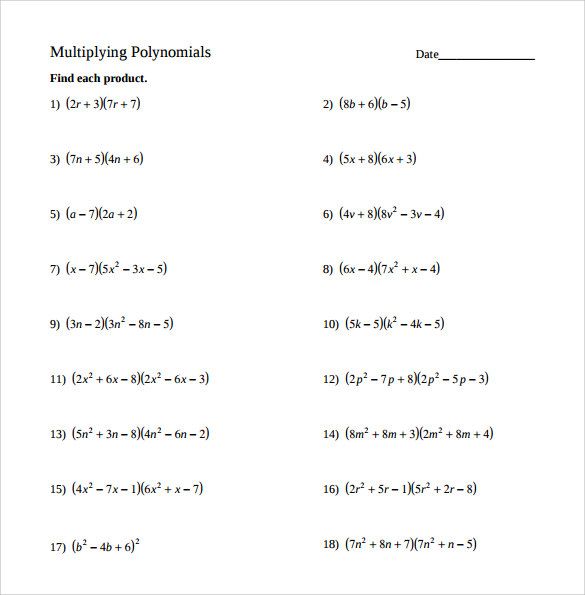Multiplying Polynomials: Free Worksheets and Tips for Success

Multiplying polynomials can be a complex task for students venturing deeper into algebra. This process, however, is fundamental for understanding higher mathematical concepts and applications. Here's a comprehensive guide with free worksheets and tips for success to help you master multiplying polynomials.
Understanding Polynomial Multiplication

Before diving into multiplication, it's crucial to understand what polynomials are. A polynomial is an expression consisting of variables and coefficients, involving only the operations of addition, subtraction, multiplication, and non-negative integer exponents of variables. Here's a brief recap:
- Monomials: A single term, like 3x or 7y.
- Binomials: A polynomial with two terms, like x + 2 or 3y - 1.
- Trinomials: A polynomial with three terms, for example, x^2 + 2x + 1.
- Multinomials: Polynomials with four or more terms.

Multiplying Polynomials by Monomials

Multiplying a polynomial by a monomial is relatively straightforward. Here's how you do it:
- Multiply each term of the polynomial by the monomial.
- Combine like terms if necessary.
For example, if you want to multiply 3x by (x + 2):
- 3x * x = 3x^2
- 3x * 2 = 6x
The result is 3x^2 + 6x.
Multiplying Binomials by Binomials

The FOIL method (First, Outer, Inner, Last) is popular for multiplying two binomials:
- First terms: Multiply the first term in each binomial.
- Outer terms: Multiply the outer terms in the product.
- Inner terms: Multiply the inner terms.
- Last terms: Multiply the last term in each binomial.
For instance, to multiply (x + 2) by (x - 1):
- F: (x * x) = x^2
- O: (x * -1) = -x
- I: (2 * x) = 2x
- L: (2 * -1) = -2
Add these together, and you get x^2 + x - 2.
Multiplying Polynomials by Polynomials

For polynomials with more terms, you distribute each term in the first polynomial by each term in the second and then combine like terms. Here's an example with a trinomial and a binomial:
Let's multiply (x^2 + 2x + 1) by (x + 3):
| Multiplication | Result |
|---|---|
| x^2 * x | x^3 |
| x^2 * 3 | 3x^2 |
| 2x * x | 2x^2 |
| 2x * 3 | 6x |
| 1 * x | x |
| 1 * 3 | 3 |

After performing these multiplications, combining like terms gives you:
- x^3 + 5x^2 + 7x + 3
📝 Note: Always double-check your work by factoring back the result to ensure correctness.
Worksheets for Practice

To reinforce your understanding of polynomial multiplication, here are some free worksheets to download:
These worksheets come with various exercises designed to:
- Reinforce the FOIL method.
- Strengthen distribution skills.
- Enhance proficiency in combining like terms.
✨ Note: Print out these worksheets and practice regularly to master polynomial multiplication.
Tips for Success

Here are some tips to help you excel in multiplying polynomials:
- Understand the Process: Before you dive into calculations, take a moment to understand the process of multiplying polynomials, whether it's using the distributive property or the FOIL method.
- Stay Organized: Keep your work organized to avoid confusion. Use a systematic approach to distribute terms.
- Check Your Work: After you finish multiplying, factor the result to verify if you get the original polynomials.
- Practice Regularly: Algebra skills improve with practice. Use the provided worksheets and other resources to maintain proficiency.
- Ask for Help: Don't hesitate to reach out to your teacher or use online forums if you get stuck.
Summary and Moving Forward

Multiplying polynomials is an essential algebraic skill with applications in many scientific and engineering disciplines. By understanding the basic operations of polynomial multiplication, mastering the techniques like FOIL or distribution, and practicing regularly with the provided worksheets, you'll find this aspect of algebra much more manageable. Remember to stay organized, check your work, and seek help when necessary. With these tools at your disposal, you'll soon be adept at multiplying polynomials with confidence.
What is the best way to check my work after multiplying polynomials?

+
The best way to check your work is to factor the result of your multiplication back into the original polynomials. If the factors match the original polynomials, your multiplication is correct.
Can I use a calculator or software for multiplying polynomials?

+
Yes, while doing it manually helps solidify understanding, tools like graphing calculators, computer algebra systems (CAS), or online polynomial calculators can be useful for verification or in complex cases.
What’s the significance of learning polynomial multiplication?

+
Polynomial multiplication is fundamental in algebra, physics, engineering, and computer graphics, among other fields. It’s crucial for solving equations, understanding functions, and working with data models.